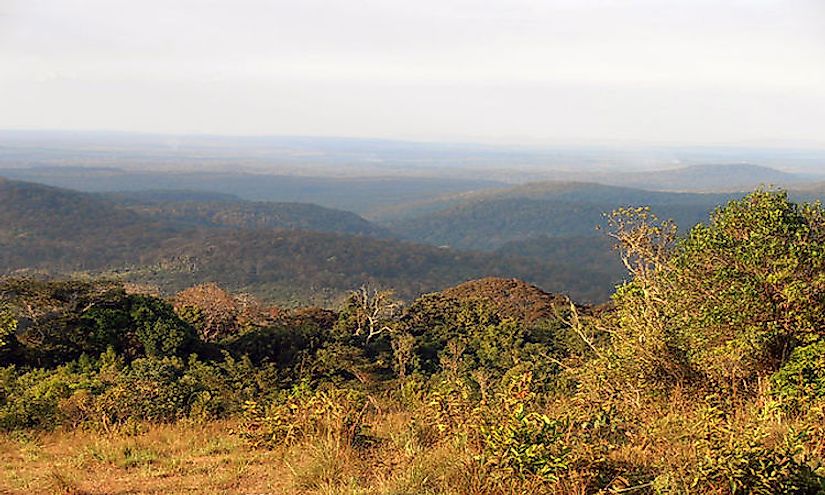Highest Mountains In Cambodia

Cambodia covers an area of 181,000 square kilometers and lies within the tropics. Its landscape is made up of mainly by low-lying plain which are surrounded by uplands and low mountains. The Mekong River flows through the country in the eastern region while transitional plains merge with the eastern highlands on the East of Mekong. The eastern region is also characterized by forested mountains and high plateaus that extend to the neighboring Laos and Vietnam. The highest peak in Cambodia rises to 5,949 feet above the sea level, the remote and inhabited Phnom Aural. The highest mountains of Cambodia include;
Highest Mountains In Cambodia
Phnom Aural
Phnom Aural is the tallest mountain in Cambodia at an elevation of 5,948 feet above the sea level. The mountain is located in the eastern part of the Cardamom Mountains in the Aoral District, Kampong Speu Province. The area around Phnom Aural is sparsely populated because of its remoteness. As a conservation measure and to protect the wildlife around Phnom Aural Mountain, Phnom Aural Wildlife Sanctuary was established. The sanctuary contains over ten species of large mammals including tigers, elephants, and leopards, and several birds’ species. The mountain is covered by bamboo trees. Wild boars loiter on the mountain, especially at night. There is a Buddha shrine at the summit of Phnom Aural Mountain. Buddhist considers the mountain a sacred place of prayer and often climbs to the top to offer their prayers.
Phnom Samkos
Phnom Samkos is the second highest mountain in Cambodia at an elevation of 5,633 feet above the sea level. The peak is located in the western part of the Cardamom Mountains. Phnom Samkos is surrounded by the Phnom Samkos Wildlife Sanctuary which is named after the mountain. The areas around Phnom Samkos Mountain support a large variety of rare flora and fauna some of which are unique to Cambodia. The Wildlife Sanctuary is a major tourist attraction in the area. The mountain is home to diverse wildlife including about 25 species of large mammals, 30 species of small mammals, several birds and amphibian species, and a wide range of floral species.
Khmaoch
Khmaoch, also known as Phnum Khmaoch, is the third highest mountain in Cambodia at an elevation of 5,466 feet above the sea level. The peak is located near Yelandu, Karnataka, India. Khmaoch Mountain also falls within the Phnom Samkos Wildlife Sanctuary and contains similar flora and fauna characteristics. It is part of the protected area within the sanctuary because of the rare biodiversity it contains. The peak is inhabited by large mammal species including the elephants, tigers, and leopards. Antelopes and gazelles are also common on Khmaoch although their numbers have greatly reduced because of the effects of illegal hunting.
Threats And Conservation Measures
The mountains of Cambodia have been severely exploited both by locals and non-locals. The communities around the mountains and the wildlife sanctuaries have taken advantage of the slow enforcement of the environmental protection policies to exploit and illegally access the mountains. Illegal and uncontrolled logging is taking place both within the protected areas and the unprotected area. Hunting for game meat has significantly affected the population of wildlife with the antelopes the most affected. Agricultural activities around the mountains and on the sides of the mountain are threatening the development and growth of the biodiversity in the area. However, the government has increased patrols and the number of officers guarding these protected areas with strict penalties including fines and jail terms for those who exploit the areas illegally.
Highest Mountains In Cambodia
| Rank | Highest Mountains in Cambodia | Elevation |
|---|---|---|
| 1 | Phnom Aural | 5,948 feet |
| 2 | Phnom Samkos | 5,633 feet |
| 3 | Khmaoch | 5,466 feet |
| 4 | Chrey Mlu | 5,310 feet |
| 5 | Krachau | 5,233 feet |
| 6 | Kbal Roessei | 4,606 feet |
| 7 | Yav Yai | 4,458 feet |
| 8 | Tumpor | 4,307 feet |
| 9 | Thma Chang | 4,198 feet |
| 10 | Khla Khmum | 4,118 feet |







